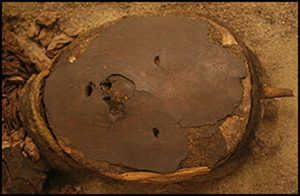Crossref Citations
This article has been cited by the following publications. This list is generated based on data provided by
Crossref.
Fiore, Danae
Butto, Ana
and
Vargas Filgueira, Victor
2021.
Yagan Heritage in Tierra del Fuego (Argentina): The Politics of Balance.
Heritage,
Vol. 4,
Issue. 4,
p.
3790.
Bongers, Jacob L.
Mejía, Juliana Gómez
Harper, Thomas K.
and
Seidensticker, Susanna
2022.
Assembling the dead: human vertebrae-on-posts in the Chincha Valley, Peru.
Antiquity,
Vol. 96,
Issue. 386,
p.
387.
Montt, Indira
Valenzuela, Daniela
Cases, Barbara
Santoro, Calogero M.
Capriles, José M.
and
Standen, Vivien G.
2023.
Chinchorro fibre management in the Atacama Desert and its significance for understanding Andean textilization processes.
Journal of Anthropological Archaeology,
Vol. 71,
Issue. ,
p.
101530.
Sitzia, Luca
Power, Ximena
Zurro, Debora
Maalouf, Jean Paul
Cárcamo, José
Chandía, Kristopher
Vega, J. M. Alonso
Borie, César
Roa, Constanza
Silva, Claudia
Salazar, Diego
Vivanco, Sebastián
Hernández, Valentina
Aliste, Catalina
Ibacache, Sebastián
and
Lorca, Rodrigo
2023.
Tracking kelp-type seaweed fuel in the archaeological record through Raman spectroscopy of charred particles: examples from the Atacama Desert coast.
Archaeological and Anthropological Sciences,
Vol. 15,
Issue. 11,
Sepúlveda, Marcela
Ballester, Benjamín
Cabello, Gloria
Gutiérrez, Sebastián
and
Walter, Philippe
2023.
Polychromy in the Atacama Desert during the Late Intermediate Period (1000–1450 AD): pigments characterization by XRF and VNIR hyperspectral images.
Archaeological and Anthropological Sciences,
Vol. 15,
Issue. 8,
Arriaza, Bernardo
Figueroa, Leonardo
Ogalde, Juan Pablo
Standen, Vivien
Halcrow, Siân
Amarasiriwardena, Dulasiri
Van Hoesen, John
and
Castelleti, José
2023.
An archaeometric approach to biocontamination with manganese pigments in ancient marine hunter-gatherers of the Atacama Desert: health, ideological, and socioecononic considerations.
Archaeological and Anthropological Sciences,
Vol. 15,
Issue. 12,
Arriaza, Bernardo
Ogalde, Juan Pablo
Gutiérrez, Sebastián
Cárcamo, José
Standen, Vivien
and
Figueroa Tagle, Leonardo
2024.
Evidencia arqueométrica del uso del manganeso en artefactos asociados a la cultura Chinchorro.
Latin American Antiquity,
Vol. 35,
Issue. 1,
p.
246.
Pedraja-Rejas, Liliana
Rodríguez-Ponce, Emilio
Muñoz-Fritis, Camila
Garrido-Tamayo, Miguel-Ángel
Vélez, Javier
and
Laroze, David
2025.
Chinchorro culture: An analysis from the learning perspective.
Social Sciences & Humanities Open,
Vol. 11,
Issue. ,
p.
101309.



